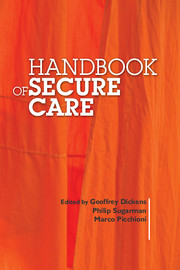Book contents
- Frontmatter
- Contents
- List of tables, boxes and figures
- List of contributors
- Preface
- 1 The evolution of secure and forensic mental healthcare
- 2 Mental disorder and offending
- 3 Clinical risk assessment in secure care
- 4 Risk management in secure care
- 5 Recovery in secure environments
- 6 Personality disorder
- 7 Women's mental health, aggression and offending
- 8 Offenders with intellectual disability in secure services and the criminal justice system
- 9 Secure mental healthcare for young people
- 10 Secure care for people with autism spectrum disorder
- 11 Acquired brain injury, trauma and aggression
- 12 Managing aggression and violence in older people
- 13 Firesetting in secure settings: theory, treatment and management
- 14 Specialist psychological treatment programmes in secure mental healthcare
- 15 Nursing in secure mental healthcare settings
- 16 Prescribing for specialist populations
- 17 Human rights in secure psychiatric care
- 18 Quality assurance and clinical audit in secure psychiatric care
- 19 Psychological support following violent assault and trauma: what works for staff in secure settings?
- Index
13 - Firesetting in secure settings: theory, treatment and management
Published online by Cambridge University Press: 02 January 2018
- Frontmatter
- Contents
- List of tables, boxes and figures
- List of contributors
- Preface
- 1 The evolution of secure and forensic mental healthcare
- 2 Mental disorder and offending
- 3 Clinical risk assessment in secure care
- 4 Risk management in secure care
- 5 Recovery in secure environments
- 6 Personality disorder
- 7 Women's mental health, aggression and offending
- 8 Offenders with intellectual disability in secure services and the criminal justice system
- 9 Secure mental healthcare for young people
- 10 Secure care for people with autism spectrum disorder
- 11 Acquired brain injury, trauma and aggression
- 12 Managing aggression and violence in older people
- 13 Firesetting in secure settings: theory, treatment and management
- 14 Specialist psychological treatment programmes in secure mental healthcare
- 15 Nursing in secure mental healthcare settings
- 16 Prescribing for specialist populations
- 17 Human rights in secure psychiatric care
- 18 Quality assurance and clinical audit in secure psychiatric care
- 19 Psychological support following violent assault and trauma: what works for staff in secure settings?
- Index
Summary
Introduction
Background and aims
Firesetting confers substantial costs on society. In 2010/2011 there were 36 000 deliberately set fires in Great Britain resulting in 72 fatalities and 1700 non-fatal casualties. Around one in five deliberate fires occur in nondwelling buildings, including hospitals (Department for Communities and Local Government, 2011). While serious fires in psychiatric hospitals are reasonably rare, incidents in UK secure mental health units in recent years, at Stockton Hall in North Yorkshire in 2010 (BBC News, 2010) and Camlet Lodge in London in 2008 (James, 2008), have demonstrated that fire can seriously disrupt service provision and endanger life. Additionally, the total number of incidents in psychiatric hospitals attended by the fire and rescue service is disproportionately greater per bed than in general medical hospitals (Grice, 2012). Around 10% of people admitted to forensic psychiatric services have committed arson (Coid et al, 2001) and many more may have a history of problematic firesetting behaviour (Geller et al, 1992). It is important therefore that staff who work in these services hold sufficient practical and theoretical knowledge to contribute to the prevention of firesetting and to the assessment, treatment and management of firesetters in secure care.
This chapter briefly reviews the epidemiology of firesetting, its relationship with mental disorder and the prevalence of firesetting among particular patient groups who may be resident in secure care. We then describe established theories of firesetting, including motivational typologies, single-factor theories and previous attempts at multifactor theories. We then present a newly developed multi-trajectory theory of adult firesetting (M-TTAF; Gannon et al, 2012a). This theory is important because it proposes different motivational drivers and prominent risk factors for firesetting across various groups, many of whom may be characterised by particular psychopathological features common in secure settings. The implication is that different groups will hold different risk factors and require varying therapeutic approaches. Some psychological treatment interventions delivered in secure settings are then examined. Finally, we discuss aspects of practical risk assessment and management of firesetters in the secure environment.
- Type
- Chapter
- Information
- Handbook of Secure Care , pp. 193 - 210Publisher: Royal College of PsychiatristsPrint publication year: 2015

